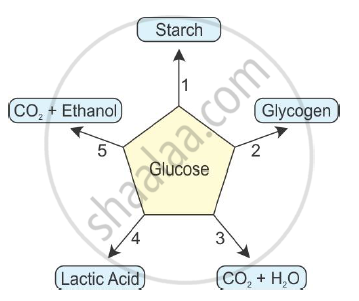Advertisements
Advertisements
प्रश्न
Some sugar solution is taken in a test-tube and a little of substance X in powder form is added to it. The mouth of test-tube is closed with a cork and allowed to stand for sometime. On opening the cork, a characteristic smell of substance Y is obtained and a gas Z is also observed to be formed. The gas Z extinguishes a burning matchstick.
(a) What could be (i) X, (ii) Y, and (iii) Z?
(b) What is the process of converting sugar into substance Y by the action of X known as?
(c) What type of respiration is exhibited by X in the above process?
उत्तर
(a) (i) X is yeast. (ii) Y is ethanol. (iii) Z is carbon dioxide.
(b) Fermentation is the process of converting sugar into substance Y by the action of X.
(c) Anaerobic respiration is exhibited by X in the above process.
APPEARS IN
संबंधित प्रश्न
Given below are the end products of different reactions involving glucose.

Write the reaction number in front of the following:
(i) Anaerobic reaction =
(ii) Reaction in the human muscles =
(iii) Aerobic respiration =
(iv) Reaction in the plant cells =
(v) Reaction in the liver
Carbon dioxide enters into the leaves through tiny pores present on the surface of the leaf called _________.
(a) chlorophyll
(b) chloroplast
(c) stomata
(d) epidermis
List the differences between aerobic and anaerobic respiration.
During heavy exercise, we get cramps in the legs due to the accumulation of ______.
Given below is a square of letters in which are hidden different words related to respiration in organisms. These words may be present in any direction − upwards, downwards, or along the diagonals. Find the words for your respiratory system. Clues about those words are given below the square.

- The air tubes of insects
- Skeletal structures surrounding chest cavity
- Muscular floor of chest cavity
- Tiny pores on the surface of leaf
- Small openings on the sides of the body of an insect
- The respiratory organs of human beings
- The openings through which we inhale
- An anaerobic organism
- An organism with tracheal system
Which part of roots is involved in the exchange of respiratory gases?
Fill in the following blank with suitable word:
Gills are the breathing organs in ___________.
Describe the process of respiration in fish.
Explain how, it would benefit deep sea divers if humans also had gills.
Give the main points of difference between respiration in plants and respiration in animals.
Which of the following statements are true about respiration?
(i) during inhalation, ribs move inward and diaphragm is raised.
(ii) the gaseous exchange takes place in the alveoli.
(iii) haemoglobin has greater affinity for carbon dioxide than oxygen.
(iv) alveoli increase surface area of the exchange of gases
An organism X having breathing organs A lives on land. When organism X goes underwater, it cannot survive for a long time unless carrying an oxygen cylinder. On the other hand, the organism Y having breathing organs B always lives in water and if taken out of the water, it dies after a short while. A third organism Z having breathing organs C and D which lives on the banks of ponds, lakes, and rivers can survive on land as well as in water equally well.
(a) What could organism X be? Name the breathing organs A.
(b) What could organism Y be? Name the breathing organs B.
(c) What could organism Z be? Name the breathing organs C and D.
(d) Out of X, Y, and Z, which organism is (i) amphibian, (ii) aquatic, and (iii)
terrestrial?
An animal in which the oxygenation of blood does not take place in the lungs is:
Differentiate between
External respiration and Internal respiration
Choose the odd one out in the following groups of four items each:
Trachea, Bronchus, Alveolus, Diaphragm
Which chemical compound inside a cell can be termed "Currency of Energy"?
Differentiate between the following pairs on the basis of the aspect given in the brackets.
Tidal volume and Residual volume (Quantity of air)
The partial pressure of oxygen of blood in pulmonary capillaries is i ______ mrnHg while in alveolar air it is ii ______ mmHg.
Explain the three pathways of breakdown in living organisms.
Yeast is used in wine and beer industries because it respires
